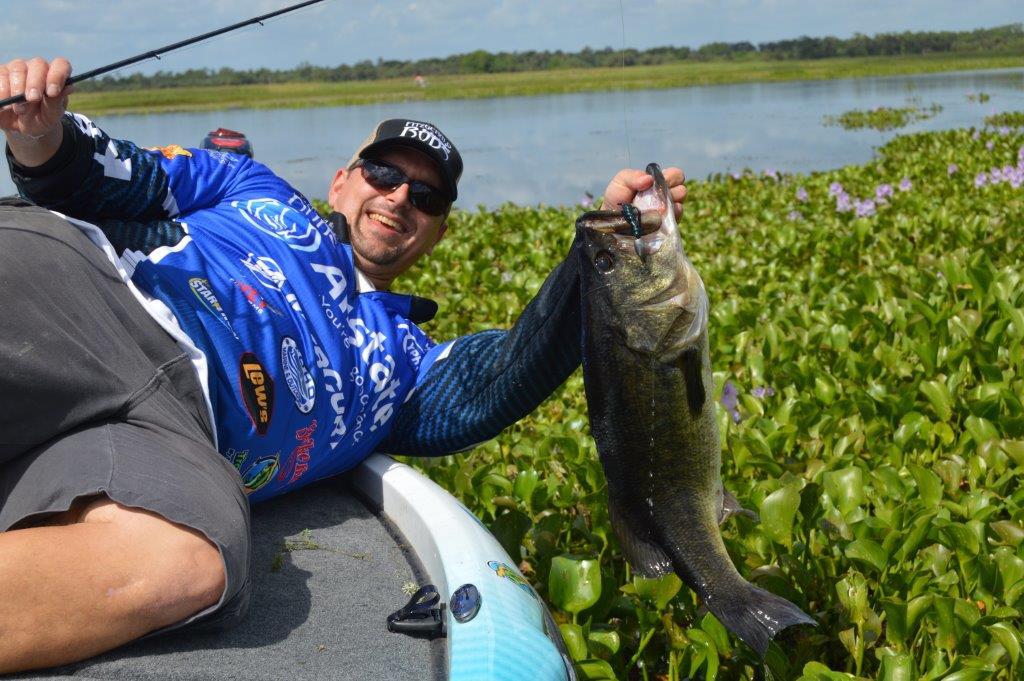Find the right vegetation for monster sized Florida bass
Kissimmee Chain of Lakes
Floating Mats
[print_link]
“During fall and throughout winter on the Kissimmee Chain of Lakes in Central Florida, punching mats is one of the top ways to catch a trophy bass,” said Pro Angler Rich Howes, while bombing another creature bait through a dense mat of water hyacinth. “I target areas of hydrilla where its thick and topped out and canopied with some form of floating vegetation like water-hyacinths or water-lettuce. That’s the basic structure of a mat. I also look for what other types of plants are intertwined with it such as duckweed, water meal, dollar weed, cow lily, bulrush, and maidencane which are all productive plants to target when found in conjunction with a mat.” During summer, Howes approach begins at the outer edge of each mat until fall and winter when he changes its center. “During summer, I’ll start by dropping baits in a circular pattern, slowly working around its edge towards the center as a lot of fish will stage in the shade on its outer edge. By winter, fish gravitate towards the middle because that’s where the majority of heat is stored and they’ll hold tight underneath.”

Punching is a fairly simple technique albeit physically demanding as flipping heavy hunks of tungsten weight with a glorified pool cue can wear your forearm out in a hurry. Rigged with a monster sized hook and a very diminutive soft plastic creature bait, the heavy pointed shape of the punching weight allows it to penetrate the mat and descend to the bottom. It sometimes takes a little finesse of the rod to get it to work through if it didn’t slide down on the first try, but once you feel the bottom, you just lift the rod tip up and yo-yo the bait a few times within the open cavities then let it back down slowly. Usually within the first few seconds you’ll feel the take, if not there’s probably nobody home and time to move a few yards away and punch again.
Punching Gear
For battling big fish out of extremely dense vegetation, Howes uses a Fitzgerald Classic 7’10 Mat Flipping Rod, matched with a Daiwa TATULA-R100XS Hyper Speed 8:1 bait casting reel. “For this type of fishing, you need a reel with a high gear ratio and a strong rod that loads fast. “It’s really a numbers game once you’ve eliminated unproductive water and start catching fish, so try not to waste too much time on unproductive mats. If the fish are there, they’ll strike out of reaction pretty quick. If not, keep moving until you find them.” For extracting fish from heavy roots and pad-stems Howes prefers green 65 lb. braided PowerPro line that’s tied using a Snell knot to a 4/0 Strike King Hack Attack Flipping Hook. Lure choice is a Gambler Lures BB Cricket craw bait, or Tightlines UV Whisker beaver. “On the Kissimmee Chain, I prefer dark color combinations such as June bug or Okeechobee craw. For clear water I use green pumpkin candy.” Depending on the density and thickness of each mat Howes varies his punching weight accordingly by using a 2 ounce Bass Pro Shops XPS tungsten flipping weight that’s pegged with a pair of bobber stoppers. “I put one bobber stop on top of the weight to keep it from sliding up, and the other between the weight and the hook to protect the knot from the wear caused by the weight slamming against it.”

Lake Okeechobee Kissimmee Grass
With over seven hundred square miles of surface area, Okeechobee’s shallow littoral shelf contains thousands of acres of Kissimmee grass, bulrush, and submersed vegetation like peppergrass and hydrilla. During spring, Captain Ed Zyak focuses on the Kissimmee grass lines and bulrush stands home to the chizzywink fly hatch which attracts hordes of bass feast that feast on the bream and bluegill that in turn are drawn to the flies. By summer the shad spawn is in full swing and schools of baitfish become a crucial forage for bass during early mornings when large masses migrate into the grass lines. “With so much area to explore, I try to eliminate unproductive water by riding and observing until I see fish blowing up on the outer lines of the Kissimmee grass,” said Zyak. “This works best on early mornings throughout summer and fall.”

Topwater Gear
Once he locates feeding fish on the surface, Zyak uses a weedless topwater lure capable of snaking through the overlaying stems and sheaths of Kissimmee grass, which have a tendency to grab conventional plugs trying to slide through. “I use the DOA PT-7 topwater in either glowdini or gold glitter / black back. It has the right size and profile to mimic the shad and shiner forage for this lake and being a soft plastic it walks through the grass with no hang-ups. It’s also rigged with a single extra heavy screw lock worm hook which increases your chance of extracting a big fish out of the thick grass verses a smaller treble hooked lure.” For muscling big Okeechobee bass out of the thick grass, Zyak uses a Shimano Chronarch MGL bait casting reel spooled with 50 pound PowerPro braided line, matched with a 6’8 Medium Heavy Shimano Expride rod. “This combo is ultralight in weight, it can cast the lure a mile, and the rod has the power to set the hook and get a big fish’s head above the grass where it can’t bury down.”
End
Story & Photos by Dustin Catrett


